Menu
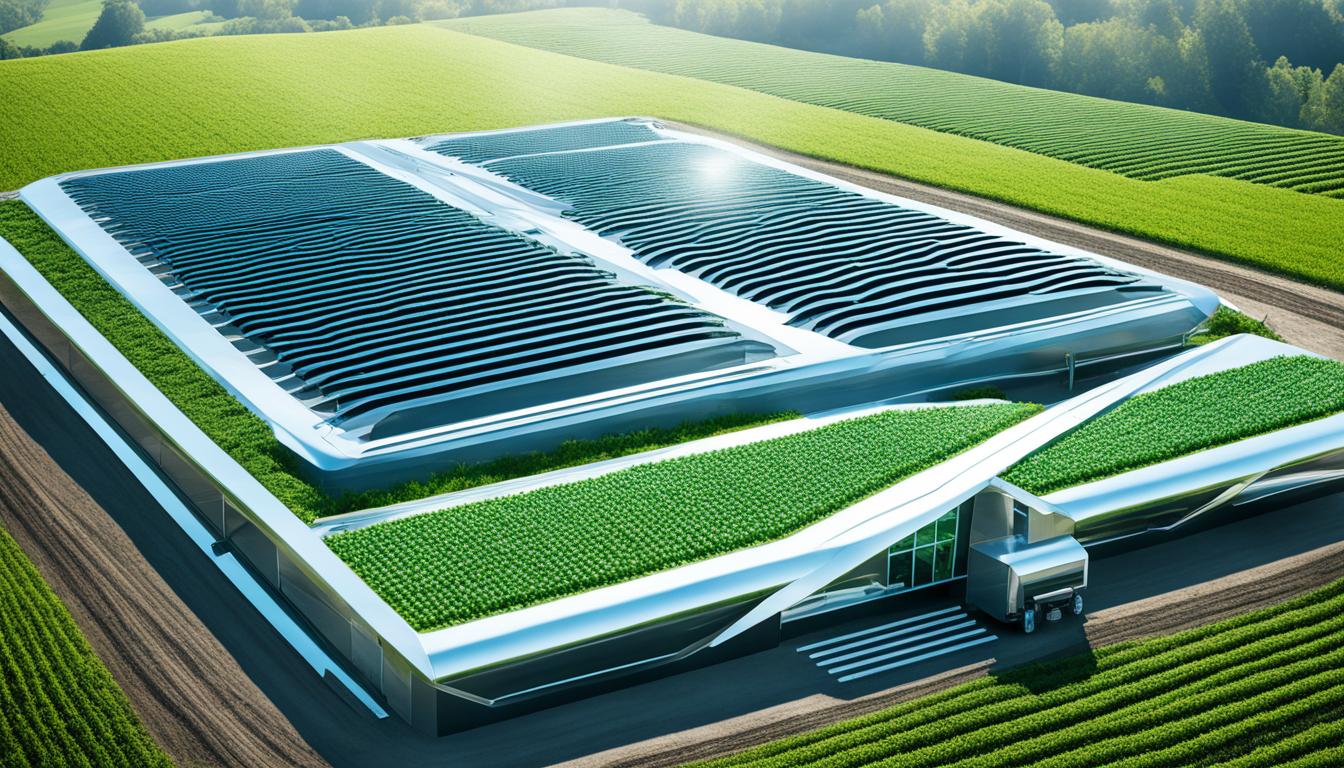
Did you know about ASHT courses? Each cohort gets to attend four two-day training sessions. These sessions happen over 12-18 months. The programme, starting spring 2024, will change how we think about soil and farming technology.
The Soil Health Institute is at the front, pushing for better farm practices. Their aim is to store more carbon on farms. This change is good for the environment. It helps water quality, makes ecosystems stronger, and can make farms more profitable. It works by making more nutrients available, helping bees and other pollinators, and making farms better at handling dry spells.
AFT is helping by giving money for travel to ASHT participants. Full-course people can get up to $4,000, and for each session, it’s $1,000. If you design a plan to improve soil health, you could get another $1,000. The programme teaches a lot, like how to take care of soil, how to plan, and good ways to talk about soil health.
The sessions also give personal help. They look at the needs of each farm. This hands-on approach is why the programme is so effective. Those who finish can help lead the future of farming. Plus, they get paid for their efforts in making farms healthier.
Soil health tech uses the latest science to tackle farming’s big problems. It helps make our soils more alive and productive. This is a big step forward in making agriculture more eco-friendly.
Studies show that healthy soil boosts farm yields and keeps nature in balance. Global Policy says no-till farming increases crop growth and locks more carbon in the ground. This makes farming more sustainable.
Nature’s 2015 report found that it also raises soil quality, which helps crops grow better. This proves how crucial soil health is for farming and feeding the world.
Regenerative farming helps more than just current agriculture. It renews the soil completely and supports nature. This brings benefits like storing nutrients, holding water better, and having more types of life.
A 2012 study highlights the role of soil microbes in making soil richer for plants. It’s a win for both farmers and the environment. Plus, the European Journal of Soil Science shows city soils can boost or harm human health. This shows why all soils, even in cities, need to be looked after.
| Study Year | Journal | Key Findings |
|---|---|---|
| 2013 | Global Policy | No-till management improves crop productivity and soil carbon sequestration. |
| 2015 | Nature | Conservation agriculture can enhance soil quality and crop yields. |
| 2012 | Frontiers in Plant Science | Manipulating soil microbiome benefits soil health and plant fertility. |
| 2018 | Sustainability | Need for cohesive European soil protection legislation. |
| 2018 | European Journal of Soil Science | Urban soils significantly impact human health. |
Accurate soil analysis is key in today’s farming. It helps both farmers and experts know the soil’s health. This knowledge boosts crop growth and keeps the environment in balance. Thus, farming methods have greatly improved.
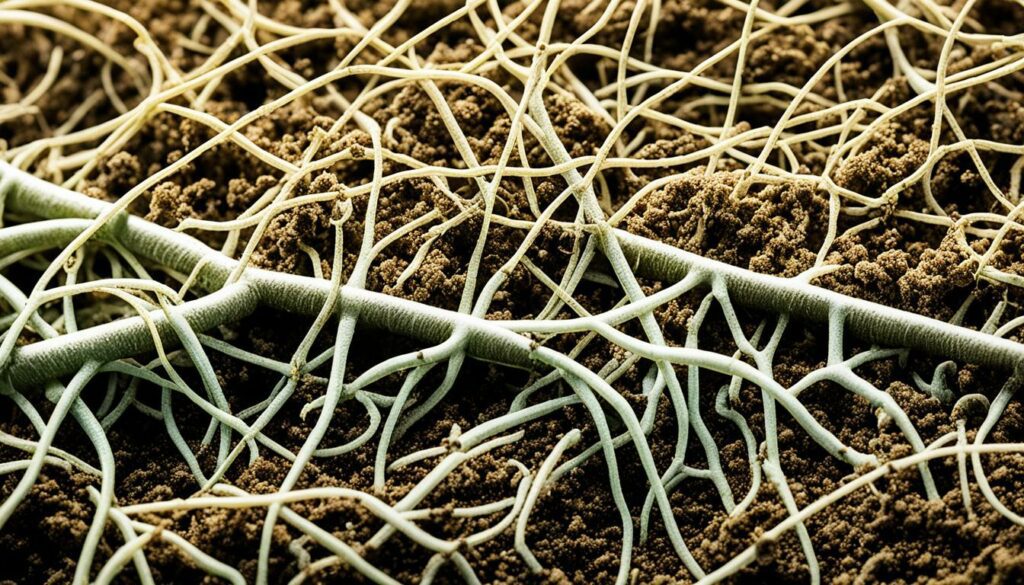
In 2015, Brevik EC and others showed how important detailed soil analysis is. They highlighted how using precise methods can help. A 2016 study by Baveye PC, focused on soil’s role in nature and farming. It stressed the need to examine soil carefully.
Knowing how to read soil health data is vital for good farming. Bünemann EK and others wrote about this in 2018. It helps farmers choose the right crops and how to use fertilizers right. Keith AM and team’s 2016 work linked good soil care to healthy ecosystems and public health.
Studies keep showing that soil analysis helps both money and the planet. A 2019 paper by Karlen DL highlighted these wins. It pointed out how accurate soil data leads to sustainable farming. This boosts farm yields while keeping nature in check for the long haul.
Using sustainable farming is key for lasting success in agriculture. It focuses on practices like regenerative farming. These methods help the soil heal naturally and become healthier.
Regenerative agriculture aims to make farms better for nature. It does this by increasing the number of different plants and animals. This makes the soil richer and helps fight climate problems better.
Farmers can follow specific steps to farm sustainably. This includes using tools and following regenerative farming guidelines. Among these are:
These methods don’t just help farmers earn more. They also make farming good for the environment in the long run.
To learn more about this, visit the IEEE Climate Change Plant and Soil Health page.
Precision agriculture is key in improving soil health. It brings the latest tech to farms for better management. This tech lets farmers closely watch and adjust soil conditions. It uses high-tech tools to boost how much food we grow while keeping farms eco-friendly. This method is all about reducing variations in food production and fixing imbalances in soil nutrients.
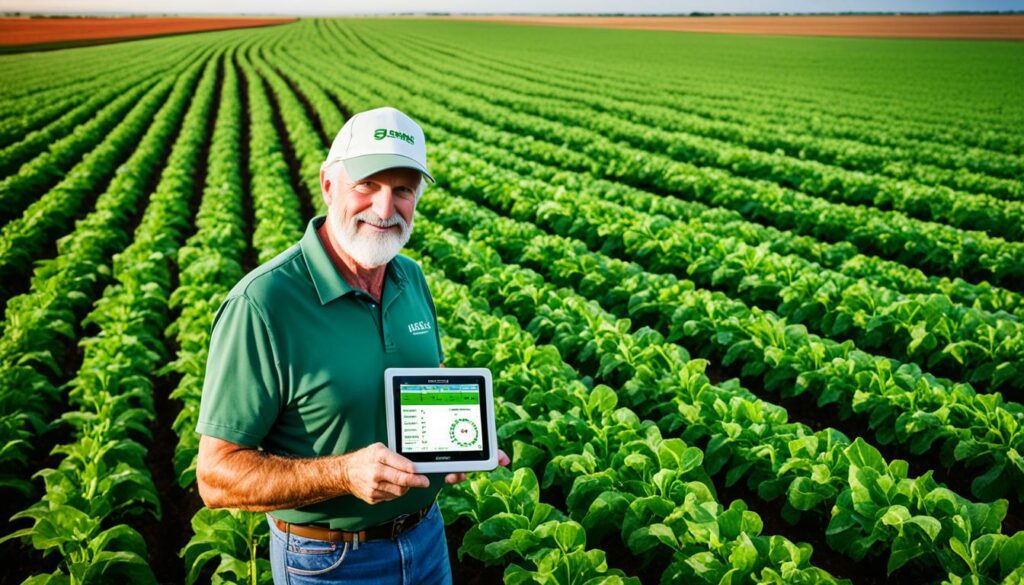
Today, using the latest tech in farming is a clear sign of moving forward. New research looks at how the levels of phosphorus (P) and potassium (K) in soil affect crop yields. These studies show that nutrients in soil don’t spread evenly. This highlights why monitoring soil health closely is crucial. Farmers use tools like DGPS and yield monitors to keep track. But, they need a plan that fits their specific field, not a general one, since soil nutrients vary from place to place.
| Technology | Application | Benefits |
|---|---|---|
| DGPS | Field mapping | Accurate geo-referencing |
| Soil Sensors | Nutrient level monitoring | Real-time data collection |
| Yield Monitors | Harvest data logging | Improved yield tracking |
GPS and sensors are changing the face of farming. They keep a close eye on soil health to help farmers make smart moves. Methods like grid soil sampling offer rich details on nutrient levels. This helps farmers make decisions that are spot-on. Additionally, techniques like infrared spectroscopy are making quick soil checks easier without the hassle of pulling samples.
Finding the perfect method for taking soil samples isn’t easy, but precision agriculture is making big strides here. For example, using different amounts of fertilisers depending on the fields’ needs works well. This approach keys in on practices such as cover crops and less tilling to make the soil better. So, combining precision farming with keeping soil healthy is at the heart of farming’s high-tech wave.
Advances in digital agriculture are changing how we grow food. Now, farmers can use tech to manage resources better. This includes innovative tools and techniques for farming.
One company leading the digital change is FarmRaise. They are among others using technology to boost crop growth. This is good news as it can mean healthier farms and more food for everyone.
Vence, a major player, recently got bought by Merck Animal Health. This merger shows just how important digital farming has become. The sector is booming with investments in soil health tools, sustainable dyes, and even robot farmers. These new technologies are about more than just profits. They’re also about looking after the environment and making farming smarter.
Our planet needs help, and many think farming is part of the problem. But now, there’s hope in using digital methods for good. Digital farming is not just about growing crops. It’s also making the land healthier and farming more sustainable.
The South is a leader in digital farming tools, with over 700 innovators helping small farmers. These tools are making farming fairer and more efficient. They’re also making it easier for everyone to get the food they need.
The world will need a lot more food soon to feed everyone. That’s why digital farming is so important. It’s in our future to rely on smart farming. Technologies like AI will be key in making this happen.
Sustainable soil management practices are vital for keeping soil healthy. Two top methods are rotational grazing and cover cropping. They are key in keeping soil fertile and the environment thriving.
Rotational grazing benefits are huge. It stops soil from being packed down and stops grass from being overeaten. This can reduce the amount of rainwater that flows off the land and stop soil microbe homes from being destroyed.
Moving animals between different fields keeps the plants’ roots strong. This helps many different tiny organisms in the soil. This also avoids high soil temperatures that can mess with nutrient cycles. Using this method, farmers can make sure the soil is full of nutrients all year round.

Soil management practices also include cover crops. Cover crops have many benefits. They make the soil strong, stop it from washing away, and help the web of life underground stay active all year.
Crops like legumes fix nitrogen, an important nutrient, in the soil. This makes it easy for other plants to use. The top layer of these crops keeps the ground moist, stops it from getting too hot, and keeps weeds away. It’s a perfect place for soil life to thrive.
Planting different crops with cover cropping brings in new food for soil organisms. This mix reduces the chance of diseases and pests in crops. As these plants die off, they become food for the soil, keeping it healthy with organic matter.
Using these methods improves soil and cuts down on costs. It also increases how much food we can grow, following the ideas of good farming.
Boosting soil health and making it more fertile are key for better farming. There are two big projects working on this now. They are looking closely at soil nutrients like phosphorus (P) and potassium (K). They want to know how these affect plant health and crop yields.
Advanced farming technologies are important in these projects. One is doing large field studies without changing anything. The other is trying out different fertiliser amounts and new tech on farms. They measure crop yields very carefully to see what works best.
How we sample soil shows us that nutrients are not spread out evenly. This is because of different soil types, the land’s shape, and farming methods. It’s hard to find one way to sample soil that works for everyone. But, testing soils for P and K is still good for knowing what fertilisers to use.
The effect of testing soil nutrients and using different fertiliser amounts changes a lot. It depends on how the soil responds and its nutrient levels. Trials in Iowa suggest that most fields have enough P and K. So, using different amounts of P fertiliser might not help much in fields with plenty of nutrients.
Looking at many farms, we can see that using smart technologies can really help the land. They make sure each field gets the exact fertilisers it needs. This is important as soil’s nutrient needs are not the same everywhere.
“Precision agriculture technologies are changing the way we look at soil health,” says an expert. “They are very good at making soil better and increasing nutrients.”
To manage soil well, a mix of methods is used. This includes using chemical and natural fertilisers, farming different crops each season, and planting the right seeds for the area. Plants that take nitrogen from the air help make the soil better, cutting the need for some fertilisers.
New methods use special isotopes to study how well plants use fertilisers and how to keep soil healthy. Using small amounts of fertilisers and planting certain crops also helps keep the soil full of nutrients.
| Soil Fertility Technique | Description | Benefits |
|---|---|---|
| Grid Sampling | Assessment of soil nutrient variability at a granular level | Enhanced precision in fertiliser application |
| Variable-Rate Fertilisation | Applying different rates of fertiliser across a field | Optimised nutrient application and cost savings |
| Cover Crops | Planting crops to cover soil during off-season | Increased organic matter and improved soil structure |
| Leguminous Crops | Crops that fix atmospheric nitrogen | Reduced need for nitrogen fertilisers |
| Micro-Dose Fertilisation | Precise application of small fertiliser doses | Improved nutrient efficiency and reduced losses |
Using nuclear and isotopic methods can help make fertiliser use more efficient. This way, we can make sure farms stay productive but also look after the environment.
Today, advanced crop monitoring systems are key in farming. They use tech to collect and analyse farm data in real time. This helps farmers make quick decisions to improve how products are grown while caring for the environment.
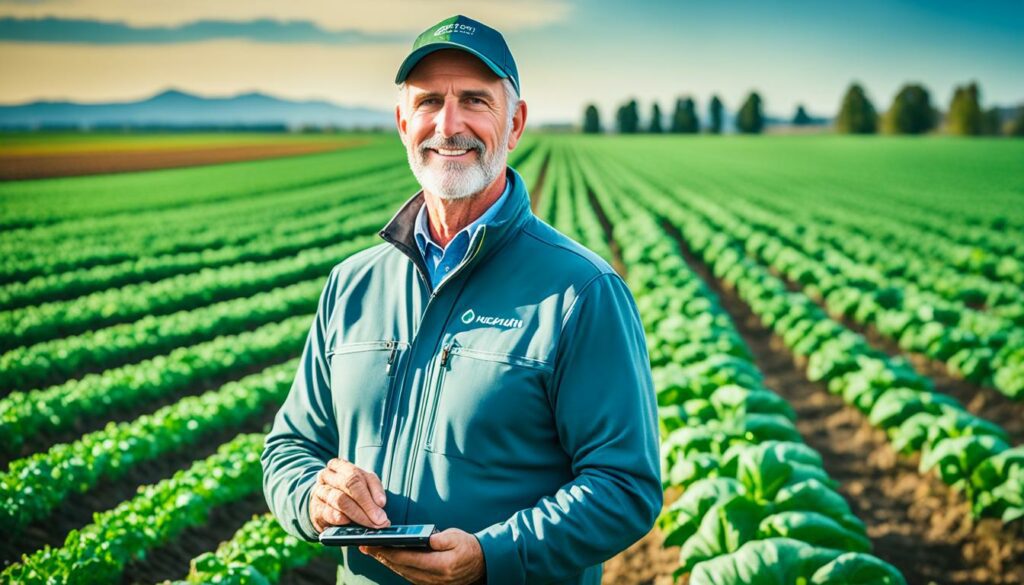
Getting real-time data is crucial for farming nowadays. IoT and AI let farmers watch over key health points of crops, such as moisture and nutrient levels. For example, smart ways to use water can save up to half of it, yet keep the plants healthy. Plus, drones and cameras with AI can spot issues early, like diseases or pests. This means farmers can act fast, which is great for the health of their crops.
High-tech monitoring can directly boost crop yields. It uses data to make farming more efficient. For example, by looking at satellite images, farmers can see how their plants are doing and adjust things if needed. This also includes using drones with RFID for collecting data more efficiently and being better for the planet, as they use less power. These technologies play a huge part in feeding our growing world. By 2050, there will be 10 billion people, and we’ll need all the crops we can get.
Adopting a whole-systems agricultural model is key to fighting soil health problems. Instead of treating just the signs, it tackles the root causes. It does this by considering the whole ecosystem, leading to stronger and greener farming ways.
The impact of soil degradation is serious:
Because of such worrying figures, moving to farming that looks at the whole system is vital. This kind of farming boosts soil health, leading to cleaner water, more varied plant and animal life, and helps fight climate change. These changes aim for farms to prioritize soil health by 2025, which will make them more productive and profitable.
Under Dr. Wayne Honeycutt’s guidance, the Soil Health Institute (SHI) has championed the adoption of practices that improve soil health. They’ve shown that these practices are good for both the economy and the planet. Key strategies include crop rotations and using cover crops, which are vital for the health of the soil.
In the field of potato farming, planting cover crops around harvest time is making big soil health improvements. These strategies are based on solid evidence and are part of a wider approach aiming to restore the land. This helps in making farms more sustainable.
The benefits of the whole-systems model are evident. It not only deals with immediate soil health issues but also ensures farms can thrive in the long run, while keeping the environment in balance.
Improving soil health is key in the battle against climate change. It allows carbon to be buried in the soil, lowering harmful gas emissions from farms.
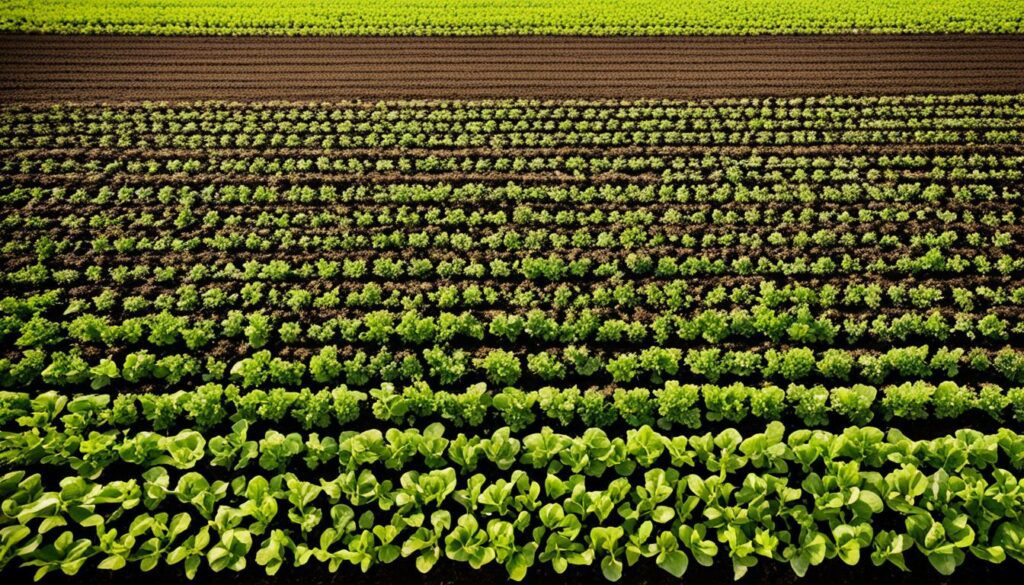
Most soils in the EU are in bad shape, up to 70%. This is from overuse of chemicals, poor crop plans, and too much machinery. Capturing carbon into the soil is vital. This happens when farmers don’t plough, which lowers gas releases.
Switching crops in turns is good for capturing carbon. It also helps fight pests and makes water cleaner. Adding special stuff to the soil can grow more carbon stores and make the soil better for tiny life.
Globally, farms are a big source of N2O gases. Good soils let out more harmful gases than bad ones. So, by not ploughing too much, we can up the good in our soil.
Covering soil can also work wonders. It keeps moisture in, stops washout, and boosts soil life. Fields with natural edges can keep water cleaner and trap extra carbon in plants.
Effective soil management via eco-friendly farming is key to fighting climate change. It promises big cuts in greenhouse gases.
Growing seasonal crops is also smart. It means cleaner water, less weeds, and fewer pests. Special plant strips by water slow it down, protecting the land and making it better.
Agri-tech solutions change the face of farm economics, bringing in big financial wins with smart farming tools. MyLand Company Inc. is leading the way. They just got $23 million in funding. This money comes from Climate Innovation Capital (“ClimateIC”) and the Borden Family.
Because of this funding, MyLand can now expand its work out West. They will focus on making the soil better in places like the Pacific Northwest and Texas. They plan to use high-tech methods to make the land more productive.
MyLand wants to quickly make soil health better and push for farming that’s good for the Earth. This leads to bigger crop harvests, less use of resources, and soil that stays healthy. Such steps are crucial for making farming both eco-friendly and profitable.
MyLand stands out with its special tech and focus on revitalizing the soil. Their goal is to lead in today’s farming world, solving big problems along the way.
LandPrint is also making big moves in Latin American farming. They’re focusing on making the land better for growing the food Brazil needs. Their clever approach checks how good the land is for the Earth, aiming for smart farming ways. An important project with the Cargill Land Innovation Fund checked a farm in Maranhão, Brazil. It showed us just how vital good land and strong farming are.
| Company | Funding | Technological Focus | Target Regions |
|---|---|---|---|
| MyLand Company Inc. | $23 million | Soil as a Service, Innovative Soil Technologies | Pacific Northwest, Texas |
| LandPrint | Undisclosed | PAAS, Environmental Certification | Brazil, Latin America |
These smart farming technologies are not just about making more money. They are key to farming that lasts. By using these high-tech tools, MyLand and LandPrint are leading the way. They show us how farming can be both profitable and kind to our planet.
Modern farming uses advanced technology to protect our land and make profits. This includes using regenerative practices to build a strong farming future.
Farmers are now using methods that need fewer pesticides. They’ve seen the use of these chemicals drop by 50-100%. Also, these techniques are great at storing more carbon in the soil each year. This helps the water cycle and the health of the soil for future farming.
These new ways of farming can make up to $530.39 more profit per hectare each year. They also lower the costs of running a farm. This makes them a smart choice for farmers looking ahead.
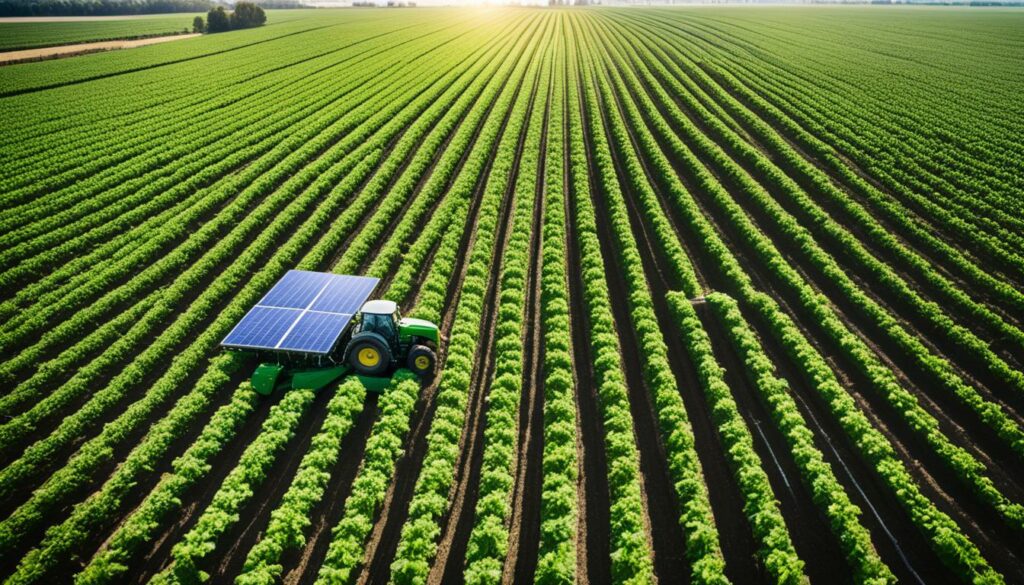
The Boston Consulting Group sees regenerative farming as a good investment for the long run. It leads to healthier soil and more plants and animals. Also, it cuts down on harmful emissions from the food we eat, helping the earth.
Regenerative farming also helps fight climate change by storing more carbon in the ground. Important people are noticing this big step. Forbes, for example, says it’s key for both the environment and the economy in farming.
With new farming methods, we can face the challenges of the future well. These methods promise a brighter, more profitable farming future that also takes care of our planet. This way, we can provide for the needs of the 21st century while protecting our environment.
Studying real-life cases in farming can show us a lot about applying soil health ideas. These stories show how using new methods can lead to big wins in farming.
Nigeria is a prime example, with its remarkable jump in cereal production. It went from 7.8 million tons in 1960 to 25 million tons by 2016. Such an increase came from using better ways to farm.
Smithfield Foods leads in making goals to cut down on gases in the protein world. Their aim is to show how farming can help the planet.
In Latin America, new farming ways are proving great for soil and making more food. They own a lot of good farming land and water, so their success is very promising.
The U.S. has rolled out the Farm Bill to boost money for green farming. This supports studying ways to make food that’s kind to the Earth. The idea is to put advanced farming tech in use across the country.
Looking at different farms teaches us a few things. First, it stresses the need to use what’s around us smartly. Matching solutions to local needs works, like in Ethiopia’s rise in chickpea demand because they studied how the population would grow.
Using smart tech in farming can jack up how much we grow without harming the Earth. In Yorkshire, experts showed that farming with less digging can keep the soil rich. It’s a win for plants and for the environment.
Finally, working together is key to spreading good farming ideas. By sharing across the globe, we can all get better at farming. This teamwork helps face the big challenges, both in farming and the environment.
| Region | Key Initiative | Outcome |
|---|---|---|
| Nigeria | Improved Cereal Production Practices | From 7.8 to 25 million tons |
| Smithfield Foods | GHG Emission Reduction Goals | Leadership in Protein Industry |
| Latin America | Adoption of Regenerative Farming | Enhanced Soil Health & Productivity |
| United States | US Farm Bill Research Funding | Support for Sustainable Food Systems |
| University of Leeds | Minimal Cultivation Practices | Improved Soil Nutrient Retention |
It’s crucial for agriculture to move forward with soil health technology. This tackles big environmental issues of our time. With these new ways, farming can become regenerative. This means it can keep going in a healthy way, making farming better and not harming the earth.
Old and new farms alike can do very well by using smart farming methods. Having strong and fertile soil is key for successful crops now and in the future. Studies point out that some farming ways, like covering the ground and not tilling the soil so much, stop soil from washing away. This keeps the soil in good shape. Livestock farms also do better when they eat well from this healthy soil, which helps the whole farm be more productive.
Healthy soil does a lot to fight climate change. It keeps carbon out of the air and cleans water. Testing the soil can give farmers tips to grow better crops and spend less. These steps clearly show the big role that soil plays in making farms strong and their lands healthy for the long run.
The work done on farms today will affect how well they do in the future. Taking care of the soil means strong and lasting farms. This way, farms can thrive without hurting the environment, meeting the needs of people now and those to come.
Soil health is essential for farming. It impacts crop yield, water retention, and the availability of nutrients. Good soil health is key for sustainable farming and ecosystem support.
Soil health tech uses GPS and sensors to offer precise data. This helps farmers track soil health. They can then make better decisions to boost efficiency and crops.
Yes, soil health tech in regenerative farming can reduce carbon and gases. This helps fight climate change.
Soil analysis is crucial for today’s farming. It gives detailed soil health data. This data guides farming decisions, improving soil and crop success.
Regenerative farming helps soil, water, and biodiversity. It aids in fixing habitats and boosts farming’s profit and eco-friendliness.
Digital farming tools collect and analyse live data. This quick data access helps in making early decisions. It betters crop health and yields.
Practising rotation grazing and cover crops help keep soil healthy. They stop soil from losing nutrients and prevent erosion. This makes farming sustainable.
Better soil fertility gives more nutrients and energy to the soil. This results in better crop quality and yields. Sustainable farming and organic methods are part of this.
Looking at the whole system finds and solves deep soil issues. This approach makes farming more durable and green.
Agri-tech tools cut costs and up crop success. They help farmers use resources smarter, bringing more returns. This links profit with planet care.
Today, farms use tech for sustainable profit. They blend good practices, precision farming, and tech solutions. This helps with modern farm issues.
Case studies prove soil tech works, showcasing good results. They offer useful tips and inspire ways to better farm sustainability and profit.